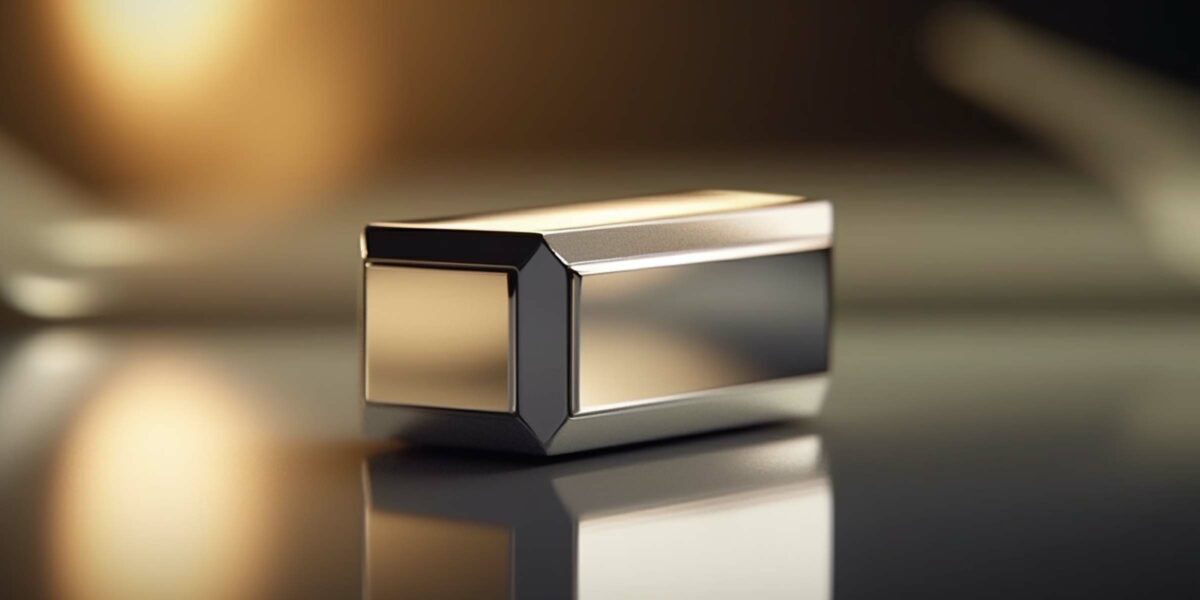Just like a fresh pair of new white sneakers or a basic white tee, white gold jewelry is a blank canvas to endless styling opportunities. And whilst it may not be the most exhilarating color choice, chances are, you’ll look down at your white gold jewelry with just as much adoration in fifty years’ time as you do at the altar.
What about silver or platinum? Aren’t they just as versatile as white gold? That may be true.
However, while the aesthetic of these three precious metals may be similar, the composition and properties are not. Hitting the elusive sweet spot between the two, white gold is a lot more valuable and durable than silver but less expensive than platinum, making it the perfect choice for any bride or groom to be.
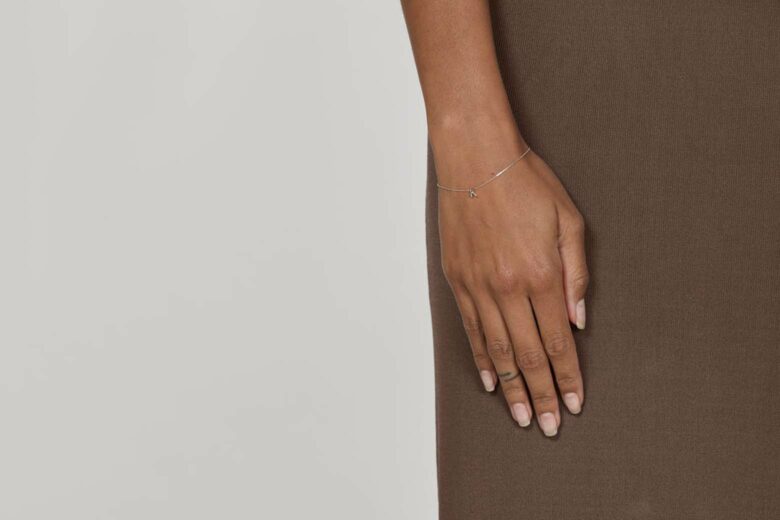
What is white gold
White gold looks like silver but acts like gold. Popularized in the 1920s, white gold was created as a lighter, more affordable alternative to palladium. Since then, it has maintained its timelessly trendy status, as one of the most sought-after precious metals for engagement rings, wedding bands, and other heirloom pieces.
Like almost all solid gold jewelry, white gold is made from an amalgamation of pure gold and other metals. Other metals are added to most types of real gold for strengthening purposes. But in the case of white gold, the alloys serve double duty—both strengthening the alloy and giving it its lustrous white coloring. In order to achieve this, white metals such as nickel, palladium, platinum, and silver are added to the gold alloy, each altering the metal in a unique way.
Besides its white hue, what really sets white gold apart from other types of gold is the additional layer of rhodium, a rare and lustrous metal. Unlike yellow gold or rose gold, white gold is coated in rhodium to give it its white sheen. This also makes white gold highly resistant to scratching and tarnishing, but it does require a bit of extra maintenance. And over time, white gold jewelry may have to be re-coated by a jeweler to maintain its scintillating aesthetic.
How white gold is made
White gold is a gold alloy made by combining pure gold with other white metals, such as silver, nickel, palladium, copper and platinum. While all white gold contains other metals, the exact composition of the white gold alloy will vary depending on various desired properties. Some white gold contains more pure gold, making it more valuable, while other types of gold contain more alloys, making them more durable.
Like all solid gold jewelry, the amount of pure gold in white gold is measured in karats, which represents the proportion of gold to other metals in the alloy. The most common types of gold are 18 karats and 14 karats. 18K white gold comprises 75% pure gold and 25% other metals. And 14K white gold comprises 58.3% pure gold and 41.7% other metals.
The composition of other metals also varies between different pieces of white gold jewelry, with each alloy contributing to different components of the metal. As one of the few white metals available at the time, silver was added in the early days, but these days it is avoided due to its susceptibility to tarnishing. Instead, nickel and palladium are used to strengthen the metal and give it its white hue. More nickel is added to create a bright and shiny aesthetic, while more palladium is generally added for a more muted, subtle appearance.
After the white gold alloy is formed, it is often coated with a thin layer of rhodium for enhanced shine and protection from scratches and tarnishing.
Is white gold real gold?
White gold may not be pure gold, but it is definitely real gold. Pure gold jewelry is very rare. And not just because it is extremely expensive, but more because gold in its purest form is usually considered to be too soft for everyday wear. This means that almost all “real gold jewelry” is made from karat gold, also called solid gold.
Contrary to popular belief, solid gold is not the same as pure gold. Pure gold refers to 24K gold that contains no other alloys. And solid gold refers to a gold alloy that is consistent throughout the jewelry piece (simply meaning that it isn’t gold plated). Solid gold is usually made up of a combination of pure gold and other metals, the ratio of which is measured in karats. 18K gold is 18 parts pure gold and 6 parts other metals, while 14K gold is 14 parts pure gold and 10 parts other metals. In order to qualify as “real gold,” gold jewelry must have a karatage of 9K or higher.
This is the same for all types of gold, whether it’s yellow gold, rose gold or white gold. And therefore any white gold piece above 9K is considered just as “real” as any other solid gold jewelry.
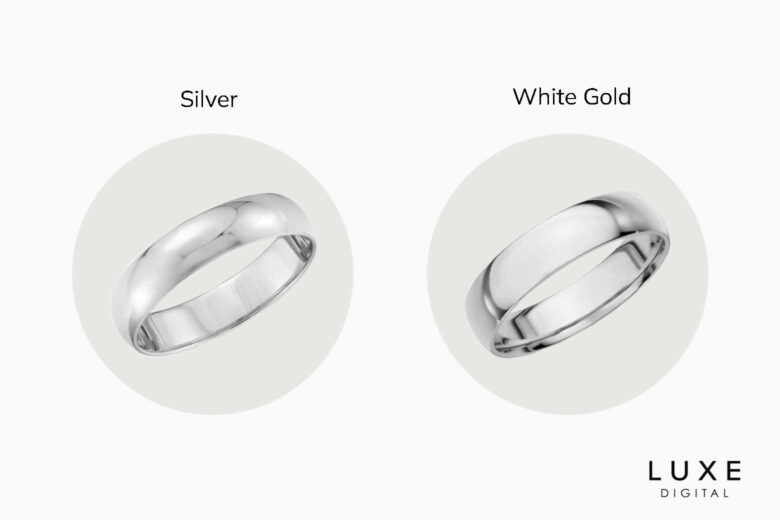
White gold vs silver
White gold and silver are both popular choices for silvery-white colored jewelry, but they have some differences in terms of their properties and characteristics.
- Composition: White gold is an alloy of gold and other white metals, such as nickel, palladium, or silver, while silver is a pure metal.
- Durability: As a gold alloy, white gold contains strengthening metals, making it harder and more durable than silver, which is a softer metal. This means that white gold is less prone to scratching, bending, or tarnishing over time.
- Value: White gold has a higher value than silver due to its gold content. Gold is a lot more valuable than silver. And even though white gold contains other metals in its alloy, it usually still holds enough gold to make it significantly more valuable than silver.
- Appearance: While silver and white gold may look similar to a novice, the difference is obvious to jewelry aficionados. White gold has a bright, white color that is similar to platinum, and silver has a more muted, grayish-white color.
- Maintenance: White gold is often coated with a thin layer of rhodium to enhance its shine and protect it from scratches and tarnishes. Although the rhodium layer can wear off, white gold usually only requires re-plating after many years of wear. Silver, on the other hand, requires regular cleaning and polishing to maintain its shine and prevent tarnish.
So, which is best for you? White gold is a better choice for those who want a more durable and valuable metal, while silver may be a better choice for those who want a more affordable and casual option.
| Composition | Durability | Value | Appearance | Maintenance | |
| White gold | Pure gold and other metals | Strong and durable | More valuable | Bright white | Re-plating every few years |
| Silver | Pure silver | Softer | Less valuable | Greyish white | Regular polishing |
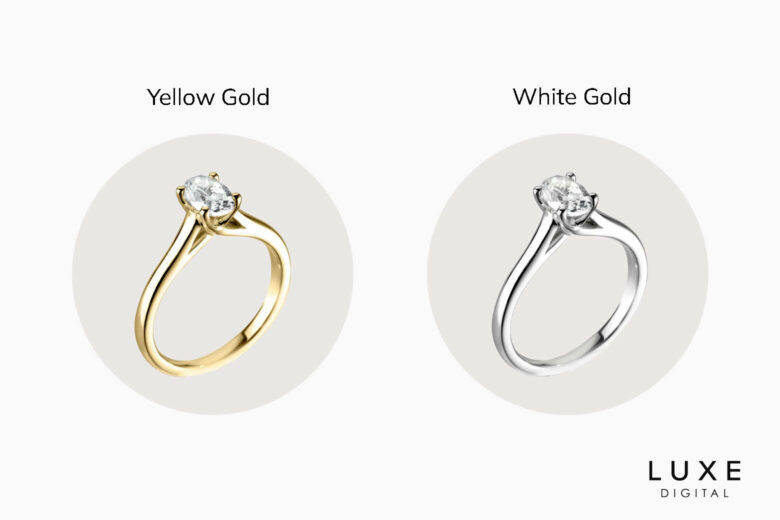
White gold vs yellow gold
Despite the noticeable difference in coloring, white gold and yellow gold are both types of gold—or rather, gold alloys, made from a combination of pure gold and other metals. So what sets them apart?
- Composition: White gold is an alloy of pure gold and other white metals, such as nickel, palladium, or silver. And yellow gold is an alloy of pure gold and other (non-white) metals, such as copper and zinc. Not only does the composition of the alloy affect the color of the gold, but it also impacts various other properties of the metal.
- Durability: The alloys used in white gold typically make it a slightly harder and more durable metal than yellow gold. This means that white gold is less prone to scratching, bending, or tarnishing over time.
- Value: The value of white gold and yellow gold is determined by the ratio of pure gold to other metals, measured in karats. The higher the karatage, the more pure gold it contains and the more valuable it is. Both white gold and yellow gold are measured in the same way, meaning that an 18K white gold ring contains the same amount of pure gold as an 18K yellow gold ring. This makes them equal in value (regarding pure gold content,) however, white gold can be slightly more expensive due to the processes used to manufacture it.
- Appearance: The most obvious difference between white gold and yellow gold is their color. White gold has a silvery-white color, while yellow gold has a warm, yellowish hue.
- Maintenance: White gold is coated with rhodium which can wear off over time and require re-plating. While yellow gold demands very little maintenance.
In short: white gold and yellow gold are very similar when it comes to durability, value and maintenance, and buyers usually make a decision based on personal preferences regarding appearance. White gold is considered trendy and timeless. While yellow gold is considered more traditional and classical.
| Composition | Durability | Value | Appearance | Maintenance | |
| White gold | Pure gold and other white metals | Slightly stronger and more durable | Slightly higher value | Silvery-white hue | Re-plating every few years |
| Yellow gold | Pure gold and other non-white metals | Strong and durable | Valuable | Warm yellowish hue | Low maintenance |

White gold vs platinum
White gold and platinum are very similar in appearance, but not quite as much when it comes to other properties.
- Composition: White gold is an alloy of gold and other white metals, such as nickel, palladium, or silver. While platinum is a pure metal.
- Durability: Platinum is harder and more durable than white gold, making it less prone to scratching, bending, or tarnishing over time.
- Value: Platinum is more valuable (and a lot more expensive) than white gold. In fact, its rarity and density make it more expensive by weight than any other metal.
- Appearance: Platinum has a bright, silvery-white color that is similar to white gold, but with cooler undertones.
- Maintenance: Although platinum requires very little maintenance, it can develop a unique patina when exposed to air and moisture. Whilst some find this desirable, others choose to have it polished periodically. White gold is also relatively low maintenance, although it usually requires rhodium re-plating after a few years of heavy wear.
Because platinum and white gold look so similar, price generally plays a big role in deciding which to choose. If you aren’t shopping with a budget, platinum is unrivaled when it comes to durability and value. However, if cost is an influential factor, white gold is the perfect middle ground between affordable silver jewelry and exorbitant platinum pieces.
| Composition | Durability | Value | Appearance | Maintenance | |
| White gold | Pure gold and other white metals | Strong and durable | Highly valuable | Silvery-white hue | Re-plating every few years |
| Platinum | Pure platinum | Even stronger and more durable | Most valuable metal | Silvery-white hue with cooler undertones | Extremely low maintenance |
What types of jewelry can be made with white gold?
Popular amongst some of the best jewelry brands, white gold can be used to make all kinds of quality gold jewelry, including:
- Engagement rings: White gold is a popular choice for engagement rings, particularly those featuring diamonds or other precious stones. The bright, silvery-white color of white gold provides a classic and elegant backdrop for the sparkle and brilliance of the stones.
- Wedding bands: As one of the most versatile and “gender-neutral” hues, white gold is a traditional choice for matching wedding bands. Timeless but trendy, it is durable enough for everyday wear and can be crafted into a variety of styles.
- Necklaces: Worth adding to your designer jewelry organizers, some of our favorite necklaces are made from white gold. Not only is the silvery-white color versatile enough for everyday wear, but it’s strong enough to produce an almost indestructible chain.
- Earrings: Producing some of the best earrings for women, white gold pairs beautifully with all kinds of stones—from dazzling diamonds to elegant pearls to dramatic emeralds.
- Bracelets: When it comes to the best bracelets for women, versatility and wearability are key, making white gold a popular choice for a variety of styles, including bangles, cuffs, charm bracelets, and simple chains.
As one of the most timeless, elegant, and versatile precious metals, you can seldom go wrong with a white gold jewelry piece. Although if you’re looking for a bold statement piece rather than lifelong jewelry, you may want to consider a more affordable alternative such as sterling silver.
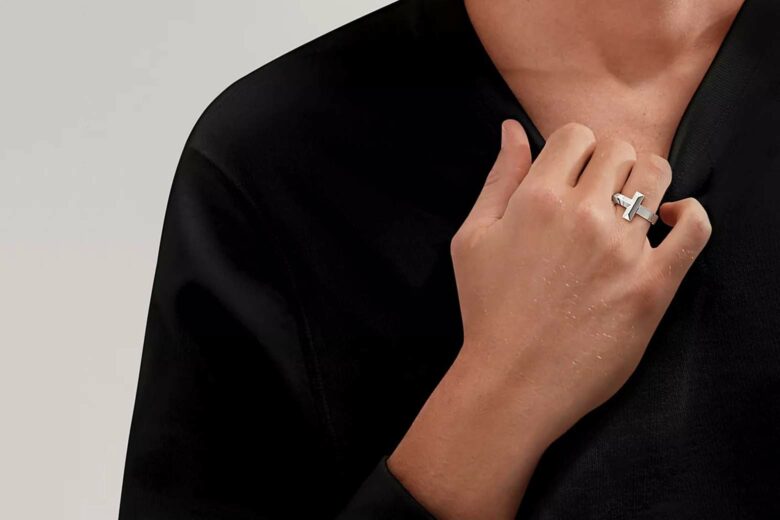
What is white gold price?
Like any other type of gold, the price of white gold can vary depending on several factors, including the current market price of gold, the quality of the white gold alloy, and the cost of labor and materials involved in creating the piece of jewelry.
When it comes to the market price of gold and the quality of gold, there is no difference between the gold found in white gold and the gold found in yellow gold. Therefore, if white gold is hallmarked as the same karat as yellow gold, the value of the two types of gold should be the same.
However, when it comes to the labor and materials involved, white gold can be marginally more expensive than other types of gold. Because it is coated in rhodium, the manufacturing process is slightly more costly and time-consuming.
Does white gold tarnish or fade?
White gold is not immune to tarnish or fading, but its resistance to these processes can vary depending on the specific alloy used and how the jewelry is cared for.
White gold jewelry is often plated with rhodium, a precious metal that has a bright, reflective finish. This also helps to protect the underlying white gold from tarnish and discoloration. Over time, the rhodium plating may wear off or become scratched, which can expose the white gold to tarnish or discoloration. When this happens, the jewelry may need to be re-plated with rhodium to restore its shine and protect it from further damage.
Check also our guides on the different types of yellow gold to learn more about what to expect when shopping for gold jewelry:
Frequently asked questions about white gold
There is no difference between the value of pure gold found in white gold and the value of pure gold found in yellow gold or rose gold. Therefore, the market price of 18K white gold should be the same as yellow gold. However, this isn’t always the case. Because white gold is coated with rhodium, the manufacturing process used is slightly more expensive, making the price of white gold marginally higher.
As one of the most scarce and durable natural metals, platinum is considered more valuable than white gold. But this also means that it is quite a lot more expensive. If money is no object, platinum is unrivaled for its unique hypoallergenic, scratch-resistant properties and lustrous aesthetic. However, if you’re looking for a more affordable alternative, white gold is a close runner-up.
Although it is more affordable than platinum, white gold is generally not regarded as cheap. If you come across cheap white gold, what you may be looking at is white gold lithium. What is white gold lithium? It’s simply a term used to describe lithium—a light silver metal with increasing value due to its role in producing renewable energy.
White gold was first manufactured as an alternative to platinum, which was a popular metal for jewelry in the early 20th century. Platinum is a rare and expensive metal, making it a luxurious option for jewelry, but it is also difficult to work with due to its hardness and high melting point. Jewelery designers sought a more affordable and easier-to-work-with alternative that could provide the same bright, silvery-white color as platinum.
